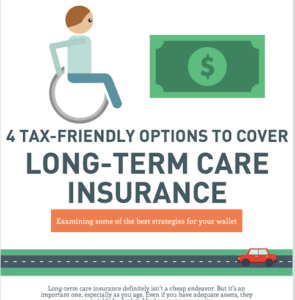Long-term care insurance definitely isn’t a cheap endeavor. But it’s an important one, especially as you age. Even if you have adequate assets, they can quickly be depleted by long-term care costs. Luckily, there are several tax-advantaged ways to help reduce the financial burden of long-term care coverage. Let’s examine some of the best strategies:
1. Tax-free transfers from permanent life insurance
Many people don’t realize this strategy is possible. Talk to a financial professional about how to correctly make a tax-free 1035 exchange from a cash-value life insurance policy to pay long-term-care premiums. The exchange can be earmarked for either a traditional long-term care policy or a policy that combines life insurance and long-term care benefits.
The money can come from the policy’s cash value, or you can use the policy’s dividends to pay the long-term-care premiums. This strategy can be useful as you age and your primary needs shift from life insurance to long-term care.
2. Tax-free transfer from an annuity
Do you have annuities as part of your retirement asset portfolio? If so, you can transfer money in a tax-free manner from one of those accounts to pay for premiums for a traditional long-term care policy. You can also use funds from an annuity to cover another annuity that also provides long-term care benefits. Called a 1035 exchange, a requirement on the transfer is that it be made directly from the annuity to pay the premiums.
Be careful: if you withdraw money from the annuity instead of doing the 1035 exchange, it will no longer be a tax-free endeavor. You’ll have to pay income taxes on the gains, which are taxed before you get back your principal. Talk to your insurer about more details behind making this type of transfer. He or she should be able to help you make the process seamless and answer any questions.
3. Long-term care insurance premiums deducted as medical expense
Good news: you can deduct part of your long-term care premiums on your taxes as a medical expense. In 2016, the limit for each person to withdraw is $390 per year if you are 40 or younger; $730 for people ages 41 to 50; $1,460 for ages 51 to 60; $3,900 for ages 61 to 70; and $4,870 for ages 71 and older. As you’ll see in the next point, you can also take a HSA withdrawal to pay the same costs, but you can’t double dip and deduct the expenses from both.
You can deduct medical expenses if they exceed 10% of your adjusted gross income, or more than 75% of your AGI if you’re age 65 or older. If you’re concerned, take note that the majority of traditional long-term care policies issued recently are eligible. If you have further questions, check out IRS Publication 502, Medical and Dental Expenses.
4. Tax-free withdrawals from Health Savings Accounts
Last but certainly not least you can withdraw money tax-free from a Health Savings Account (HAS) to cover a portion of eligible long-term care insurance premiums. See the above point for the amount you can withdraw, based on your age. An added bonus is the fact you can withdraw up to those limits free of taxes for your spouse’s coverage, too. See IRS Publication 969, Health Savings Accounts and Other Tax-Favored Health Plans, for more information.
The bottom line:
Even though long-term care insurance is expensive, there are several ways to save money in the tax department. Talk with your insurer and/or a financial professional about utilizing one of the above strategies in order to help preserve your nest egg funds for the future. Click below for a graphic illustration of everything we just covered:








